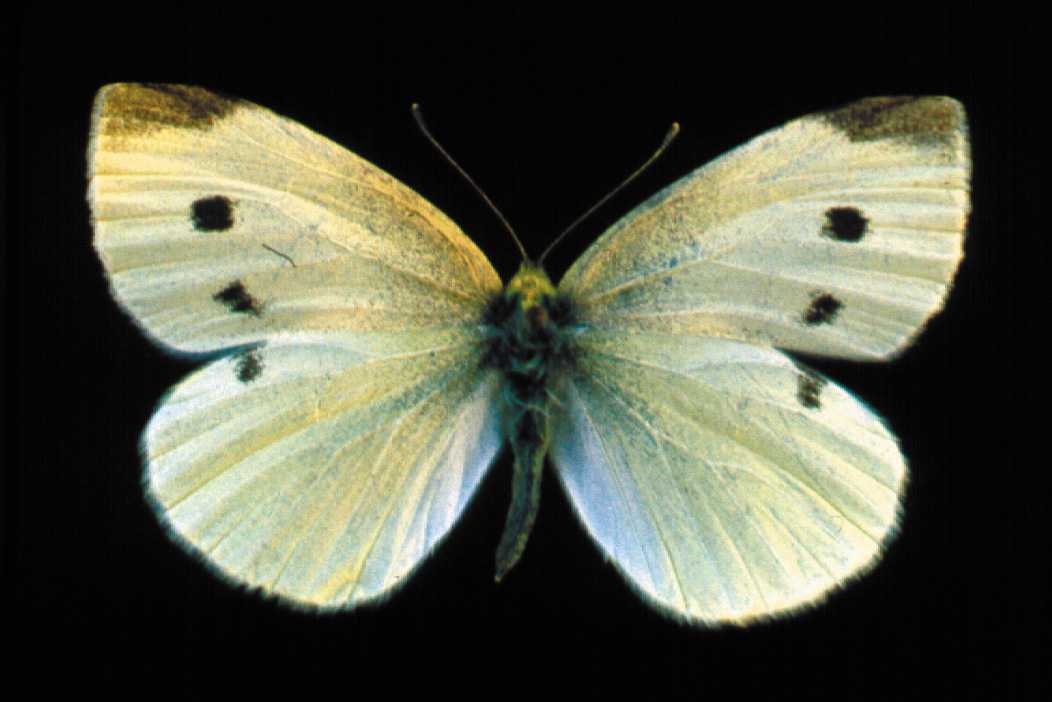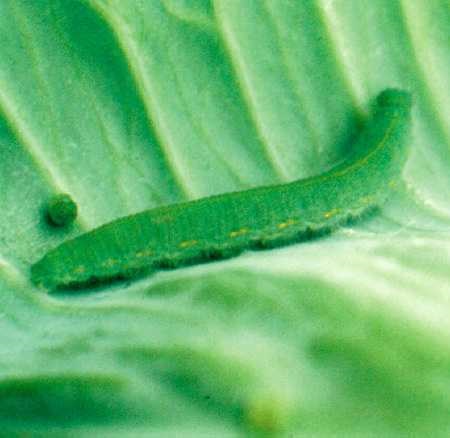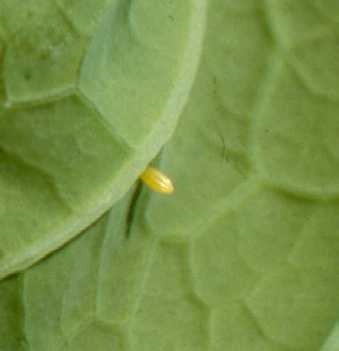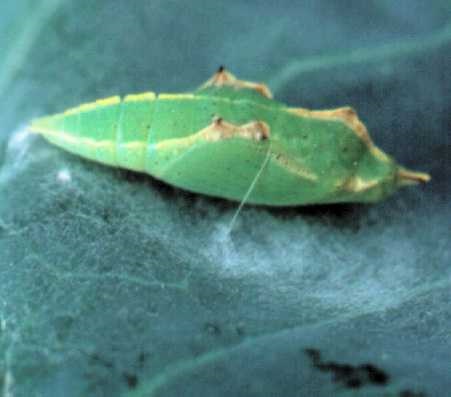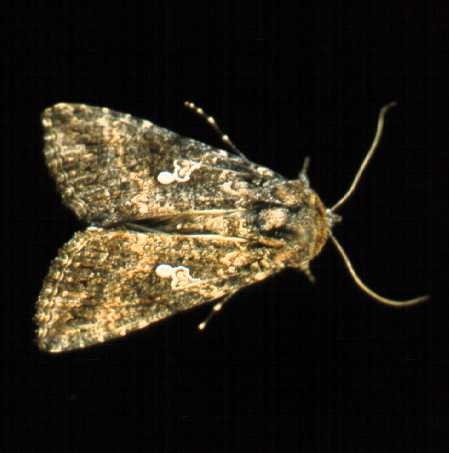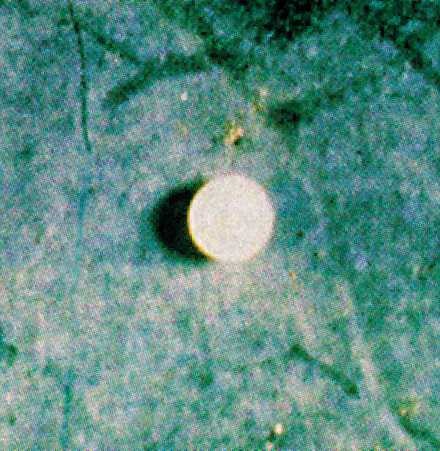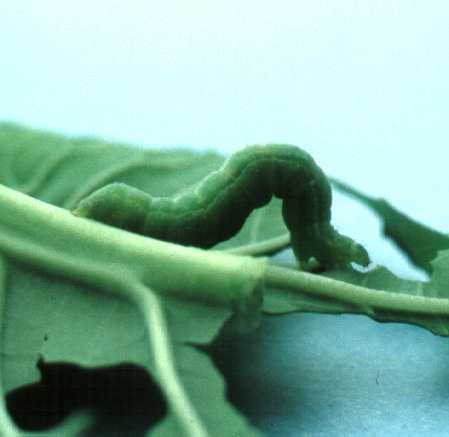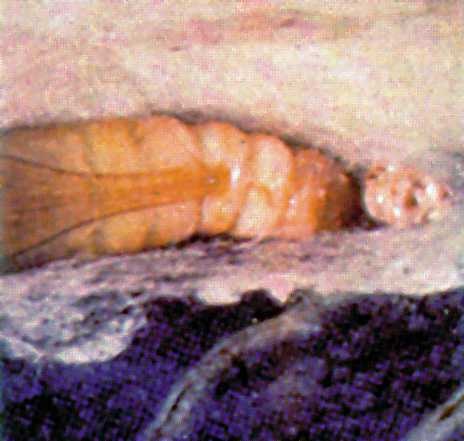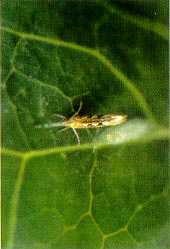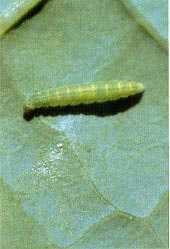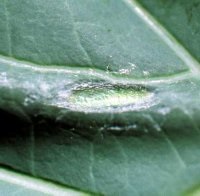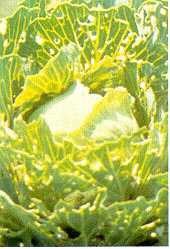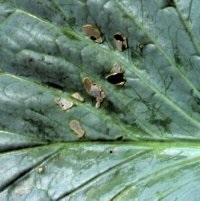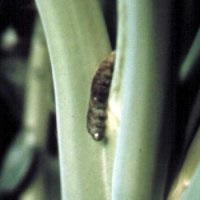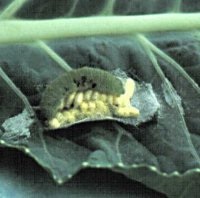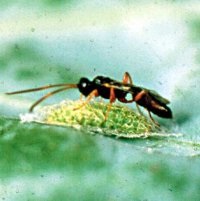Caterpillar pests of cruciferous crops
Learn about the description, biology, monitoring and control for various pests of cruciferous crops.
ISSN 1198-712X, Published May 1990
Introduction
There are 3 major caterpillar pests of crucifer crops in Ontario. The imported cabbageworm (ICW), Artogeia rapae (L.), the cabbage looper (CL), Trichoplusia ni (Hubner) and the diamondback moth (DBM), Plutella xylostella (L.). Only the cabbageworm overwinters in Ontario whereas the cabbage looper and diamondback moth migrate into Ontario during the spring. There is evidence however that in some cases in southern Ontario, the diamondback moth may be overwintering, leading to earlier larval infestations. Cull piles left throughout the winter have been identified as possible sources of diamondback moth and mild winters are known to permit more winter survival.
Description of imported cabbageworm
The adult cabbageworm is an off-white butterfly with 2 or 3 black spots on its wings (Figure 1). The butterfly, with a wingspan of about 4.4 cm can often be seen flying during the day in and around cole crop fields. Adult females can lay several hundred eggs individually placed on the underside of leaves. The small, bullet shaped eggs are white when first laid but gradually turn yellow until they hatch (Figure 2). The larvae are sluggish, velvet-green caterpillars which can grow quickly depending upon temperatures. These caterpillars also have a slender yellow stripe down the middle of the back and a broken yellow stripe along the sides (Figure 3). The well camouflaged larvae are about 3 cm long at maturity, at which point they enter the pupal stage. The pupa, which is tapered at one end and light green to light brown is attached to lower leaves, buildings or fenceposts by a silken pad (Figure 4).
Description of cabbage looper
Adult cabbage loopers are mottled grayish-brown moths that have a distinctive silvery figure eight pattern on their forewings and a slight tuft of hair behind the head (Figure 5). The moth, with a wingspan of about 3.8 cm is generally nocturnal but can sometimes be found resting on the underside of cabbage leaves during the day. Adult females of the cabbage looper also lay several hundred eggs, usually in small groups on the underside margins of leaves. The eggs are very small, rounded and white (Figure 6). After a few days larvae hatch and begin feeding on the underside of leaves. Looper larvae are light green with a white strip along each side of the body and have a characteristic "looping" habit which distinguishes them from other caterpillars on cole crops (Figure 7). At maturity, looper larvae are about 4 cm long and then pupate in webbed cocoons often on the host plants (Figure 8).
Description of diamondback moth
Adult diamondback moths are small, grayish brown moths with distinctive cream or yellow coloured, diamond shaped markings on its back (Figure 9). In addition the wing tips are flared by a fringe of long hairs. These small moths, which are just under 1 cm long, normally fly quickly from plant to plant mostly at dawn and dusk.
Diamondback moth eggs are very small, round, and yellowish and deposited on both sides of host leaves. The larvae are small, pale green caterpillars with tapered ends (Figure 10). Diamondback larvae can be distinguished from other caterpillars on cole crops by their habit of quickly wriggling and dropping from a leaf by a silken thread when disturbed. Mature diamondback larvae reach about 8 mm in length and then pupate in a loosely spun, delicate cocoon that is attached to the leaves and stems of the host plant (Figure 11).
Biology of imported cabbageworm
The imported cabbageworm overwinters as a pupa in and around cole crop fields. Adults emerge in mid- to late May and begin laying eggs. The butterflies are most active on warm, sunny days when wind speeds are low. Depending on temperatures, eggs hatch in 3–7 days and the larvae begin feeding. The larvae grow quickly to maturity in about 2 weeks.
Once mature, larvae enter the pupal stage which lasts about 2 weeks and the new adults emerge. There are 3 generations of cabbageworm in Ontario.
Biology of cabbage looper
Cabbage loopers do not overwinter in Ontario and migrate in from the south. Depending upon temperatures and wind patterns cabbage looper adults arrive in Ontario in July and August. After eggs are laid, larvae hatch in 3–5 days and begin feeding. The larvae mature in about 2 weeks and pupate. The pupal stage lasts about 2–3 weeks and adult moths emerge. There may be 1–2 generations in southern Ontario depending upon the time of arrival and temperatures during August and September.
Biology of diamondback moth
The diamondback moth has traditionally not overwintered in southern Ontario, however there is evidence that in some cases, and during mild winters, some may survive here in Ontario. The majority of adult moths arrive from the south during May and June and lay eggs on a wide range of cruciferous plants. After 5–10 days very small larvae emerge and begin feeding on the upper and lower leaf surfaces. Depending upon temperatures larvae mature and pupate in 2–3 weeks. There may be 2–4 generations per year in Ontario.
Damage
Both imported cabbageworm and cabbage looper can cause serious leaf feeding damage to cabbage, cauliflower, broccoli, Brussels sprouts and other cruciferous plants (Figure 12). Cabbage loopers are also known to damage lettuce, celery, tomato and rutabaga. Small cabbage looper and cabbageworm larvae generally feed on the underside of leaves, while more mature larvae chew large, irregular holes throughout the plant. Large amounts of dark frass can also stain cauliflower heads and make cabbage and broccoli unmarketable. Cabbage for processing can tolerate more feeding damage because many of the outer leaves are removed. Many of the Asian crucifers are also attacked by these caterpillars. Nappa-type cabbage (siew choy, da bai cai) is often seriously damaged by diamondback moth larvae. Occasionally bok choy is damaged by diamondback moth and/or imported cabbageworm larvae.
Unless populations are high, feeding damage from diamondback moth larvae on outer leaves of cabbage will have little effect on yield. If feeding occurs in the heart leaves prior to heading more losses may occur. Small diamondback moth larvae damage is characterized by small, irregular windows in the leaves while larger diamondback moth larvae leave an irregular, "shot-hole" pattern (Figure 13). Diamondback moth larvae also bore into developing Brussels sprouts.
Monitoring and control
Although black light traps and pheromone traps can be used to monitor adult populations of cabbage looper and diamondback moths, individual plant sampling for the larvae provides a more accurate picture of the potential for damage. Count larvae from at least 25 randomly selected plants throughout the field by scanning the under-sides of leaves and pulling back loose wrapper leaves. Fresh feeding damage and frass are good signs that large larvae are present. Choose 5 sites in each block, examining 5 plants at each site. Be sure to include 2 perimeter areas. Because cabbage loopers can cause more damage/larvae relative to imported cabbageworm and diamondback moth, a larval unit system has been developed to better represent the potential for damage. After totaling the number of cabbage loopers, imported cabbageworm and diamondback moth in a field, multiply the number of cabbage loopers by one, the number of imported cabbageworms by ½ and the number of diamondback moth larvae by 1/5. The sum of the resulting 3 numbers is the total larval units (cabbage looper equivalents). Dividing by the number of plants gives the larval units/plant. Threshold guidelines using the larval unit system are as follows: cabbage: 0.3 larval units per plant; cauliflower and broccoli: 0.2–0.3 larval units per plant.
A simpler method is to record the percentage of plants infested with caterpillars. Add the number of plants out of the 25 sampled that have 1 or more caterpillars, then multiply by 4. This will give the percentage of plants infested. Threshold guidelines are as follows:
- cabbage: 20%–30% before head fill; 10%–15% after head fill;
- cauliflower and broccoli: 20%–30% before heading; 5%–10 % after heading.
There are a number of natural control agents which help to reduce populations of cabbage loopers, imported cabbageworm and diamondback moth in Ontario, including predacious ground beetles, spiders, lacewing larvae, and birds. Both cabbage looper and imported cabbageworm are affected by a specific virus disease which causes the caterpillar to turn milky yellow or brown when it dies (Figure 14). More virus particles are released as the dead caterpillar decomposes.
The imported cabbageworm is also parasitized by several insect species in Ontario. Cotesia glomerata is a small wasp which parasitizes the imported cabbageworm larva. At maturity the wasp larva pupate outside of the dead imported cabbageworm larva (Figure 15). Pteromalus puparum is another small wasp which parasitizes the imported cabbage pupa and prevents the adult butterfly from developing. The fly Phryxe vulgaris also parasitizes imported cabbageworm larva, eventually killing it during the pupal stage. The main parasite of diamondback moth larva is a small wasp, Diadegma insularis (Figure 16). Other parasites of diamondback moth identified in Ontario include Diadromus plutellae (pupa) and Microplitis plutellae (larvae). Other parasitic wasps and tachinid flies parasitize cabbage looper, imported cabbageworm and diamondback moth larvae to a lesser extent. Parasitism of cabbage looper in Ontario is limited because of the pest’s migratory behaviour.
Foliar sprays are also available for control of caterpillar pests of cruciferous crops. These include commercial formulations of the bacterium Bacillus thuringiensis, which are harmless to the natural enemies of these pests. Small larvae are easier to control than large larvae and good coverage of the underside of leaves is important for effective control. The diamondback moth has become very difficult to control with insecticides in recent years. High levels of resistance are known to exist in populations of diamondback moth and during hot summers, the rapid increase in larval populations often leads to control failures. A strict rotation of available pest control products is recommended. Sprayers that have been maintained regularly, correct spray volumes and pressures as well as drop nozzles have proven to be effective. Slower ground speed, spray volumes of at least 50 gal/ac and a pressure of 100–300 psi have been shown to improve control of caterpillar pests of crucifer crops.
For a list of recommended materials, refer to OMAFRA Publication 363, Vegetable Production Recommendations; or the book Integrated Pest Management for Crucifers in Ontario, Publication 701.
